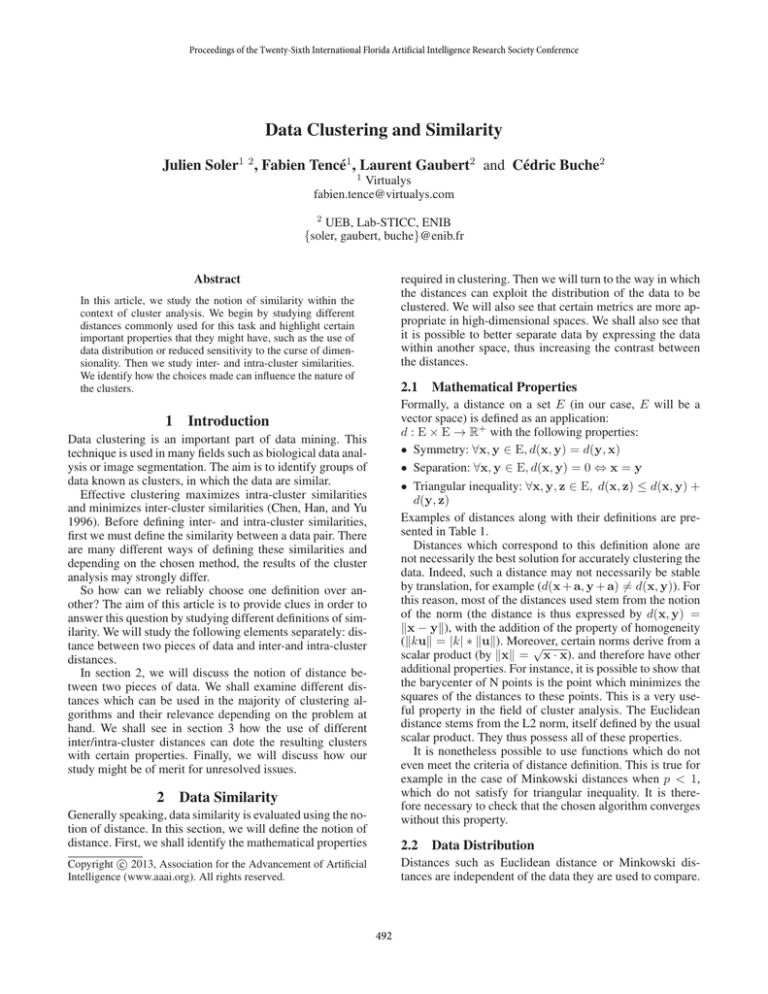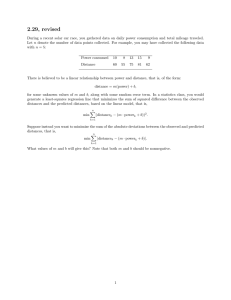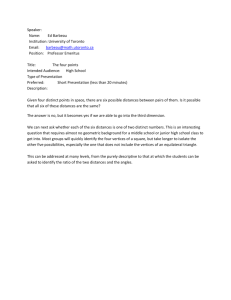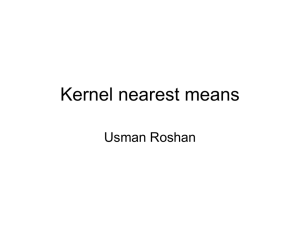
Proceedings of the Twenty-Sixth International Florida Artificial Intelligence Research Society Conference
Data Clustering and Similarity
Julien Soler1 2 , Fabien Tencé1 , Laurent Gaubert2 and Cédric Buche2
1
Virtualys
fabien.tence@virtualys.com
2
UEB, Lab-STICC, ENIB
{soler, gaubert, buche}@enib.fr
Abstract
required in clustering. Then we will turn to the way in which
the distances can exploit the distribution of the data to be
clustered. We will also see that certain metrics are more appropriate in high-dimensional spaces. We shall also see that
it is possible to better separate data by expressing the data
within another space, thus increasing the contrast between
the distances.
In this article, we study the notion of similarity within the
context of cluster analysis. We begin by studying different
distances commonly used for this task and highlight certain
important properties that they might have, such as the use of
data distribution or reduced sensitivity to the curse of dimensionality. Then we study inter- and intra-cluster similarities.
We identify how the choices made can influence the nature of
the clusters.
1
2.1
Introduction
Data clustering is an important part of data mining. This
technique is used in many fields such as biological data analysis or image segmentation. The aim is to identify groups of
data known as clusters, in which the data are similar.
Effective clustering maximizes intra-cluster similarities
and minimizes inter-cluster similarities (Chen, Han, and Yu
1996). Before defining inter- and intra-cluster similarities,
first we must define the similarity between a data pair. There
are many different ways of defining these similarities and
depending on the chosen method, the results of the cluster
analysis may strongly differ.
So how can we reliably choose one definition over another? The aim of this article is to provide clues in order to
answer this question by studying different definitions of similarity. We will study the following elements separately: distance between two pieces of data and inter-and intra-cluster
distances.
In section 2, we will discuss the notion of distance between two pieces of data. We shall examine different distances which can be used in the majority of clustering algorithms and their relevance depending on the problem at
hand. We shall see in section 3 how the use of different
inter/intra-cluster distances can dote the resulting clusters
with certain properties. Finally, we will discuss how our
study might be of merit for unresolved issues.
2
Mathematical Properties
Formally, a distance on a set E (in our case, E will be a
vector space) is defined as an application:
d : E × E → R+ with the following properties:
• Symmetry: ∀x, y ∈ E, d(x, y) = d(y, x)
• Separation: ∀x, y ∈ E, d(x, y) = 0 ⇔ x = y
• Triangular inequality: ∀x, y, z ∈ E, d(x, z) ≤ d(x, y) +
d(y, z)
Examples of distances along with their definitions are presented in Table 1.
Distances which correspond to this definition alone are
not necessarily the best solution for accurately clustering the
data. Indeed, such a distance may not necessarily be stable
by translation, for example (d(x + a, y + a) =
6 d(x, y)). For
this reason, most of the distances used stem from the notion
of the norm (the distance is thus expressed by d(x, y) =
kx − yk), with the addition of the property of homogeneity
(kkuk = |k| ∗ kuk). Moreover,
√ certain norms derive from a
scalar product (by kxk = x · x). and therefore have other
additional properties. For instance, it is possible to show that
the barycenter of N points is the point which minimizes the
squares of the distances to these points. This is a very useful property in the field of cluster analysis. The Euclidean
distance stems from the L2 norm, itself defined by the usual
scalar product. They thus possess all of these properties.
It is nonetheless possible to use functions which do not
even meet the criteria of distance definition. This is true for
example in the case of Minkowski distances when p < 1,
which do not satisfy for triangular inequality. It is therefore necessary to check that the chosen algorithm converges
without this property.
Data Similarity
Generally speaking, data similarity is evaluated using the notion of distance. In this section, we will define the notion of
distance. First, we shall identify the mathematical properties
2.2
Data Distribution
Distances such as Euclidean distance or Minkowski distances are independent of the data they are used to compare.
c 2013, Association for the Advancement of Artificial
Copyright Intelligence (www.aaai.org). All rights reserved.
492
Manhattan
Euclidean
Euclidean, Standardized
Minkowski
Chebyshev
Pn
d(x, y) = i=1 |xi − yi |
Pn
1
d(x, y) = ( i=1 (xi − yi )2 ) 2
Pn (xi −yi )2 1
d(x, y) = ( i=1 σ2 ) 2
i
Pn
1
d(x, y) = ( i=1 |xi − yi |p ) p , p ≥
1
Pn
1
d(x, y) = lim ( i=1 |xi − yi |p ) p
p→∞
1
d(x, y) = ((x − y)T S −1 (x − y)) 2
Mahalanobis
where S denotes the covariance matrix
of the dataset.
Figure 1: Illustration of the importance of the distance function on
clustering.
a) Image to be clustered
b) Manhattan Distance,
c) Euclidean Distance,
d) Standardized Euclidean Distance,
e) Minkowski Distance (p=20),
f) Mahalanobis Distance
Table 1: Defining Different Distances
However the scales of the dimensions are not necessarily
comparable. Therefore, when dealing with data relating to
a person, for example, the units of age and height are not
commensurate. By using the Euclidean distance, data clustering does not discriminate between people according to
age alone, because an age difference of one year is as big
a difference as a height variation of one meter. The standardized Euclidean distance is much more suited, as when
considering each dimension it divides its value by its variance. If we look at this in more detail, using the same example, height and age are correlated dimensions. This correlation carries additional information which can be taken
into account. The Mahalanobis distance uses the covariance
matrix of the data, thus exploiting the correlation and the
variance between the data. However, it is possible for one
of the dimensions to be proportional to another. This dimension thus becomes redundant. In such cases, the eigenvalues
of the covariance matrix are null, and the Mahalanobis distance therefore cannot be calculated. It is possible to conduct
a principal component analysis in order to detect these correlated data and to ignore them. It is interesting to note that
the standardized Euclidean distance of the data projected in
the eigenspace is equal to the Mahalanobis distance.
Figure 1 depicts image clustering conducted with a randomly initialized k-means algorithm with three centroids by
using various distances. The input data for each pixel is its
coordinates in x and y along with its red, green and blue
color (thus a 5-dimensional vector space). For each distance
function, the algorithm was run three times and the most
convincing result (as chosen by a human) was retained. We
can see the effectiveness of Mahalanobis distance and standardized Euclidean distance compared with other distances.
2.3
plained, the fractional p-distances are not distances in the
formal sense; despite this fact, they can be used to accentuate relative contrast between data. Indeed, they tend to
group data together and therefore reduce the curse of dimensionality effect. The Manhattan distance has the advantage
of both having triangular inequality and offering better data
contrast than Euclidean distance. Furthermore, it is interesting to note in Figure 1, that the clustering calculated with
the Manhattan distance does not divide the image into three
equal parts, as in the cases of the Euclidean and Minkowski
distances with p = 20. The clustering seems better than any
regular p-distance (Figure 1: b., c. and e.). Figure 2 shows the
same image clustered using a fractional p-distance (p=0.2).
Figure 2: The flower image clustered using a fractional (0.2) pdistance
The Curse of Dimensionality
2.4
When the data originate from a high-dimensional space,
we face a problem known as the curse of dimensionality.
Dimension reduction is possible by conducting a principal component analysis and retaining only the most significant dimensions. However, this method discards some of
the information. A behavioral study of the Minkowski distances on high-dimensional spaces (Aggarwal, Hinneburg,
and Keim 2001) shows that the p-distances for a high pvalue only exacerbates the problem. As we have already ex-
Data Separation
Although the curse of dimensionality poses serious problems, processing data with high dimensions also has the advantage that the data are easier to separate. In the majority
of cases, N+1 data with N dimensions are linearly separable.
In addition, Mercer’s theorem (Mercer 1909) can be used,
with a mathematical trick (the kernel trick), to describe the
data in a potentially infinite dimensional space. This trick is
used especially in classification or regression, particularly
in SVMs (Vapnik, Golowich, and Smola 1996). However
493
Cluster 1
31
0
9
48
0
4
Iris-virginica
Iris-setosa
Iris-versicolor
Iris-virginica
Iris-setosa
Iris-versicolor
Cluster 2
0
50
0
0
50
0
Cluster 3
19
0
41
2
0
46
Ascending (or agglomerative) hierarchical clustering iteratively groups together clusters with the greatest similarity (inter-cluster similarity). The result of the clustering is
strongly influenced by the choice of this metric. But these
metrics also serve to evaluate clustering quality. This evaluation can be used as a stopping criteria, or to choose the
parameters of the chosen algorithm (such as the number of
clusters for a k-means algorithm for example). In this section, we discuss the impact the choice of metric can have on
clustering.
Table 2: Matching matrices for the iris data clustering. Top:
with the Mahalanobis distance; Below: with the standardized Euclidean distance after a kernel PCA
Single linkage
Complete linkage
UPGMA or Average distance
it can also be used to conduct a kernel principal component analysis (Schölkopf, Smola, and Müller 1998). This
technique makes it possible to express the data in a higherdimensional space, in an orthogonal base. Data which are
not linearly separable in the initial space become so after
being retranscribed in the space created by this technique.
The main drawback is that the diagonalization of a M × M
matrix needs to be calculated, where M denotes the number
of pieces of data to be clustered. Table 2 presents clustering conducted by a k-means algorithm on the well-known
database of UCI iris data using the standardized Euclidean
distance of the data as expressed by a linear PCA and a kernel PCA. A k-means algorithm was used and run 3 times,
and the best result is presented in this table.
Average linkage
(variation)
d(µA , µB ) where µA and µB are the
arithmetic means of the clusters
Table 4: Common inter-cluster distances
Radius
Radius (variation)
Diameter
2.5
min(d(x, y)), x ∈ A, y ∈ B
max(d(x,
x ∈ A, y ∈ B
P y)),P
1
x∈A
y∈B d(x, y)
|A|·|B|
Summary
Diameter (variation)
We have discussed certain properties of common distances.
Table 3 presents the properties of these distances. Mahalanobis distance seems to be an appropriate choice when the
dimension number remains reasonable.
max(d(x, µA ) where µA is the
arithmetic
mean of A
P
1
x∈A d(x, µA ) where µA is
|A|
the arithmetic mean of A
max(d(x, y)), x ∈ A, y ∈ A, x 6=
y
P
P
1
x∈A
y∈A d(x, y)
|A|·(|A|−1)
Table 5: Common intra-cluster distances
Distance
Property
3.1
Manhattan
Relatively good data contrast in
high dimensions
The barycenter minimizes the
sum of the squares of the distances
The barycenter minimizes the
sum of squares of the distances,
Uses part of the data distribution
No triangular inequality, Good
data contrast in high dimensions
The barycenter minimizes the
sum of squares of the distances,
Uses data correlation
In most real problems, the dataset includes outliers. They
can be caused by a defective sensor or a typing error for example. The presence of such data, even if there are very few,
can greatly influence the inter- and intra-cluster distances.
Figure 3 illustrates these variations, with clustering conducted using SLINK (Sibson 1973), CLINK (Defays 1977)
and UPGMA. The first row shows that defining the distance
by the arithmetic mean of distances between the data of the
two groups is much more robust than using the minimum
distances of the closest data (SLINK) or the furthest data
(CLINK). Indeed, outliers have a tendency to increase intracluster distances and decrease inter-cluster distances.
Euclidean
Standardized Euclidean
Minkowski p < 1
Mahalanobis
Outlying Data
Table 3: Summary of the properties of the most common
distances
3
Cluster Similarity
Once the notion of similarity between the data is defined,
similarity of data in one cluster (intra-cluster similarity) and
similarity between clusters (inter-cluster similarity) must
also be clarified. Tables 4 and 5 present the most commonly used inter/intra-cluster distances. Indeed, these metrics are used by algorithms such as hierarchical clustering.
Figure 3: Comparison of common inter-cluster distance for hierarchical clustering on a dataset containing outlying data. The first
column corresponds to single linkage, the second to complete linkage and the third to average linkage
494
3.2
Cluster Shapes
neural networks such as self-organizing map (Kohonen
1982), Growing Cells Structure or Growing neural gas
network (Fritzke 1995), density based approach as DBSCAN (Ester et al. 1996) or OPTICS (Ankerst et al. 1999),
or agglomerative hierarchical algorithms. Again, the choice
of the best suited algorithm to the problem is not trivial
and a thorough study of the characteristics of these different approaches would be helpful. There is indeed no universal clustering algorithm achieving good quality partitioning
whatever the problem. In addition, these algorithms generally require parameters to be set correctly. Setting these parameters is a particularly difficult problem of data partitioning, because unlike classification problems, we do not have
labels indicating the “solution” which would allow one to
perform a cross-validation to adjust settings.
Finally, the difficulty to find the main specificities of a
given problem (size, density, linear separation of clusters
etc.) raises the issue already extensively discussed on visualization of high-dimensional data.
Intra- and inter-cluster distances also influence the shapes of
clusters. Of course, the definition of a radius or a diameter
for a cluster implies that the cluster is spherical. This hypothesis can be satisfactory for certain problems but not for
every case. Figure 4 illustrates the influence of inter-cluster
distance of hierarchical data clustering with clusters of various shapes. In this example, only SLINK calculates the clusters satisfactorily.
Figure 4: Comparison of common inter-cluster distance for hierarchical clustering with clusters of various shapes. The first column
corresponds to single linkage, the second to complete linkage and
the third to average linkage
3.3
References
Size and Density of Heterogeneous Clusters
Aggarwal, C. C.; Hinneburg, A.; and Keim, D. A. 2001. On the
surprising behavior of distance metrics in high dimensional space.
Database Theory—ICDT 2001 420–434.
Ankerst, M.; Breunig, M. M.; Kriegel, H.-P.; and Sander, J. 1999.
OPTICS: ordering points to identify the clustering structure. ACM
SIGMOD Record.
Chen, M.-S.; Han, J.; and Yu, P. S. 1996. Data mining: an overview
from a database perspective. Knowledge and Data Engineering,
IEEE Transactions on 8(6):866–883.
Defays, D. 1977. An efficient algorithm for a complete link
method. The Computer Journal 20(4):364–366.
Ester, M.; Kriegel, H.-P.; Sander, J.; and Xu, X. 1996. A densitybased algorithm for discovering clusters in large spatial databases
with noise. In Proceedings of the 2nd International Conference on
Knowledge Discovery and Data mining, 226–231.
Fritzke, B. 1995. A growing neural gas network learns topologies.
Advances in neural information processing systems 7:625–632.
Karypis, G.; Han, E.-H.; and Kumar, V. 1999. Chameleon: hierarchical clustering using dynamic modeling. Computer 32(8):68–75.
Kohonen, T. 1982. Self-organized formation of topologically correct feature maps. Biological cybernetics 43(1):59–69.
Mercer, J. 1909. Functions of positive and negative type, and their
connection with the theory of integral equations. Philosophical
Transactions of the Royal Society of London 69–70.
Schölkopf, B.; Smola, A.; and Müller, K.-R. 1998. Nonlinear component analysis as a kernel eigenvalue problem. Neural computation 10(5):1299–1319.
Sibson, R. 1973. SLINK: an optimally efficient algorithm for the
single-link cluster method. The Computer Journal 16(1):30–34.
Vapnik, V.; Golowich, S. E.; and Smola, A. 1996. Support vector method for function approximation, regression estimation, and
signal processing. In Advances in Neural Information Processing
Systems 9, 281–287.
Figure 5 illustrates the influence of inter-cluster distance of
hierarchical clustering of data with clusters of various sizes.
It can be seen that CLINK has difficulty clustering this type
of data.
The CHAMELEON (Karypis, Han, and Kumar 1999) algorithm offers a measurement of cluster similarity which
better accounts for the individuality of the data. It consists
to construct a k-nearest neighbors graph of the data and uses
the notions of relative inter connectivity and relative closeness of two clusters. These two aspects are defined as functions of the clusters’s internal connections and connections
between two clusters in the KNN graph. This makes it possible to account for data size and density, for example in order
not to systematically group together the small low-density
clusters into large, dense clusters.
Figure 5: Comparison of common inter-cluster distance for hierarchical clustering with clusters of various sizes. The first column
corresponds to single linkage, the second to complete linkage and
the third to average linkage
4
Discussion
In this article, we have discussed the different aspects to be
taken into account when choosing metrics for data clustering. We have shown how the properties of the most common
distances lead to a better support of many specific problems
such as size, density, shape of the clusters, or the curse of
dimensionality.
These distances are used in most of the clustering algorithms, whether centroids based algorithms as k-means,
495







